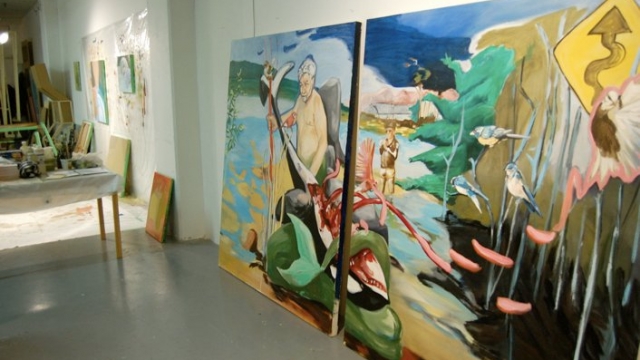
Objects Seen is the new and improved Studio Béluga's current residency exhibition, showcasing works by Hélène Juillet, Andrée Leduc, Dinao MacCormick and Katherine Pickering. Sharing Studio Béluga's 2,000 square feet of studio space and a concern for the visual, these four artists collectively bring
Established in 2009, and recently relocated from St. Henri to Mile End, Studio Béluga is both a communal studio space for resident artists to create works of art and a gallery space where those works are shown. The artist-run space demonstrates a dedicated mission to encouraging projects that push the boundaries and challenge traditional gallery models. From
We like to say that Studio Béluga came out of the space it started in — Svea Vikander had been renting this big, beautiful studio space in a St. Henri warehouse for her own artistic practice. She was at this point where she wasn't sure she could continue to keep the space on her own, but she just didn't want to give it up. We had the idea of this studio / gallery model because we wanted people to use the space like a studio – to come and make work, be part of a community but also be able to hold shows. We imagined a close involvement between the administrators and artists in residence, something really organic, unpretentious and exciting. Svea had lived in artist communities before, I'd worked in the arts too and we had both always dreamt of running an art gallery. She asked me if I really thought that would work — could we do it? — and I didn't know, but of course I said ‘yes'… Soon after, Natalia Lebedinskaia joined us, bringing her curatorial expertise, and the three of us coordinated the first residency exhibition in June 2009. Last September we moved to a larger space in the Mile End and expanded to a 10-member board of directors. This gives us a broader range of education and experience to draw from.
One of the most fascinating and inspiring things we have observed in our residencies is that often, despite artists' initial intentions, an exchange and cross-influence of ideas happens between them during the residency. This is exactly what happened during this past winter residency. The artists came in with very different views of what they wanted to do – objective and non-objective paintings, pencil drawings, and sculpture – but a commonality became apparent as their work progressed. They were all translating aspects of visual perception into their work – what conditions create and break optical illusions, ideas of framing and perspective, the gaze as it operates through photographs, things like that. Once we realized that, the concept of the show came together really quickly. Its title came from a quote by Alexander Pope, "The difference is as great between/The optics seeing as the objects seen."
What really sets us apart is the residency-gallery model. This model guarantees young artists a show, gives them a goal to work towards, and creates the most vibe and networking opportunities within the space. We're also really interested in exploring the impossible — experimental shows and work that probably wouldn't get exhibited anywhere else.
What direction are art galleries in
Until February 14